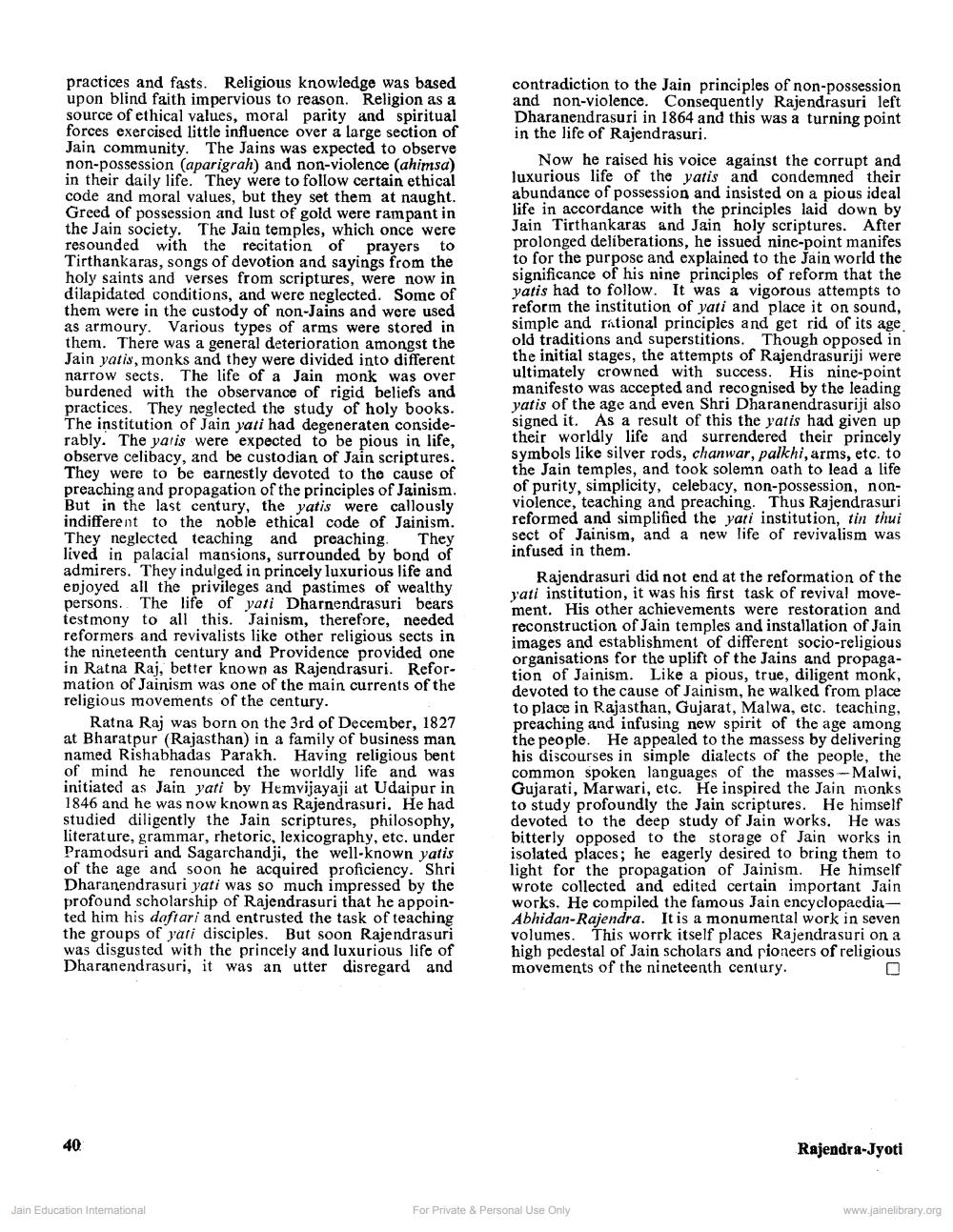________________ practices and fasts. Religious knowledge was based upon blind faith impervious to reason. Religion as a source of ethical values, moral parity and spiritual forces exercised little influence over a large section of Jain community. The Jains was expected to observe non-possession (aparigrah) and non-violence (ahimsa) in their daily life. They were to follow certain ethical code and moral values, but they set them at naught. Greed of possession and lust of gold were rampant in the Jain society. The Jain temples, which once were resounded with the recitation of prayers to Tirthankaras, songs of devotion and sayings from the holy saints and verses from scriptures, were now in dilapidated conditions, and were neglected. Some of them were in the custody of non-Jains and were used as armoury. Various types of arms were stored in them. There was a general deterioration amongst the Jain yatis, monks and they were divided into different narrow sects. The life of a Jain monk was over burdened with the observance of rigid beliefs and practices. They neglected the study of holy books. The institution of Jain vati had degeneraten considerably. The yaris were expected to be pious in life, observe celibacy, and be custodian of Jain scriptures. They were to be earnestly devoted to the cause of preaching and propagation of the principles of Jainism, But in the last century, the yatis were callously indifferent to the noble ethical code of Jainism. They neglected teaching and preaching. They lived in palacial mansions, surrounded by bond of admirers. They indulged in princely luxurious life and enjoyed all the privileges and pastimes of wealthy persons. The life of yati Dharnendrasuri bears testmony to all this. Jainism, therefore, needed reformers and revivalists like other religious sects in the nineteenth century and Providence provided one in Ratna Raj, better known as Rajendrasuri. Reformation of Jainism was one of the main currents of the religious movements of the century. Ratna Raj was born on the 3rd of December, 1827 at Bharatpur (Rajasthan) in a family of business man named Rishabhadas Parakh. Having religious bent of mind he renounced the worldly life and was initiated as Jain yati by Hemvijayaji at Udaipur in 1846 and he was now known as Rajendrasuri. He had studied diligently the Jain scriptures, philosophy, literature, grammar, rhetoric, lexicography, etc. under Pramodsuri and Sagarchandji, the well-known yatis of the age and soon he acquired proficiency. Shri Dharanendrasuri yati was so much impressed by the profound scholarship of Rajendrasuri that he appointed him his daftari and entrusted the task of teaching the groups of yari disciples. But soon Rajendrasuri was disgusted with the princely and luxurious life of Dharanendrasuri, it was an utter disregard and contradiction to the Jain principles of non-possession and non-violence. Consequently Rajendrasuri left Dharanendrasuri in 1864 and this was a turning point in the life of Rajendrasuri. Now he raised his voice against the corrupt and luxurious life of the yatis and condemned their abundance of possession and insisted on a pious ideal life in accordance with the principles laid down by Jain Tirthankaras and Jain holy scriptures. After prolonged deliberations, he issued nine-point manifes to for the purpose and explained to the Jain world the significance of his nine principles of reform that the yatis had to follow. It was a vigorous attempts to reform the institution of yati and place it on sound, simple and rational principles and get rid of its age old traditions and superstitions. Though opposed in the initial stages, the attempts of Rajendrasuriji were ultimately crowned with success. His nine-point manifesto was accepted and recognised by the leading yatis of the age and even Shri Dharanendrasuriji also signed it. As a result of this the yatis had given up their worldly life and surrendered their princely symbols like silver rods, chanwar, palkhi, arms, etc. to the Jain temples, and took solemn oath to lead a life of purity, simplicity, celebacy, non-possession, nonviolence, teaching and preaching. Thus Rajendrasuri reformed and simplified the yati institution, tin thui sect of Jainism, and a new life of revivalism was infused in them. Rajendrasuri did not end at the reformation of the yati institution, it was his first task of revival movement. His other achievements were restoration and reconstruction of Jain temples and installation of Jain images and establishment of different socio-religious organisations for the uplift of the Jains and propagation of Jainism. Like a pious, true, diligent monk, devoted to the cause of Jainism, he walked from place to place in Rajasthan, Gujarat, Malwa, etc. teaching, preaching and infusing new spirit of the age among the people. He appealed to the massess by delivering his discourses in simple dialects of the people, the common spoken languages of the masses-Malwi, Gujarati, Marwari, etc. He inspired the Jain monks to study profoundly the Jain scriptures. He himself devoted to the deep study of Jain works. He was bitterly opposed to the storage of Jain works in isolated places: he eagerly desired to bring them to light for the propagation of Jainism. He himself wrote collected and edited certain important Jain works. He compiled the famous Jain encyclopaedia - Abhidan-Rajendra. It is a monumental work in seven volumes. This worrk itself places Rajendrasuri on a high pedestal of Jain scholars and pioneers of religious movements of the nineteenth century. 0 Rajendra-Jyoti Jain Education International For Private & Personal Use Only www.jainelibrary.org




